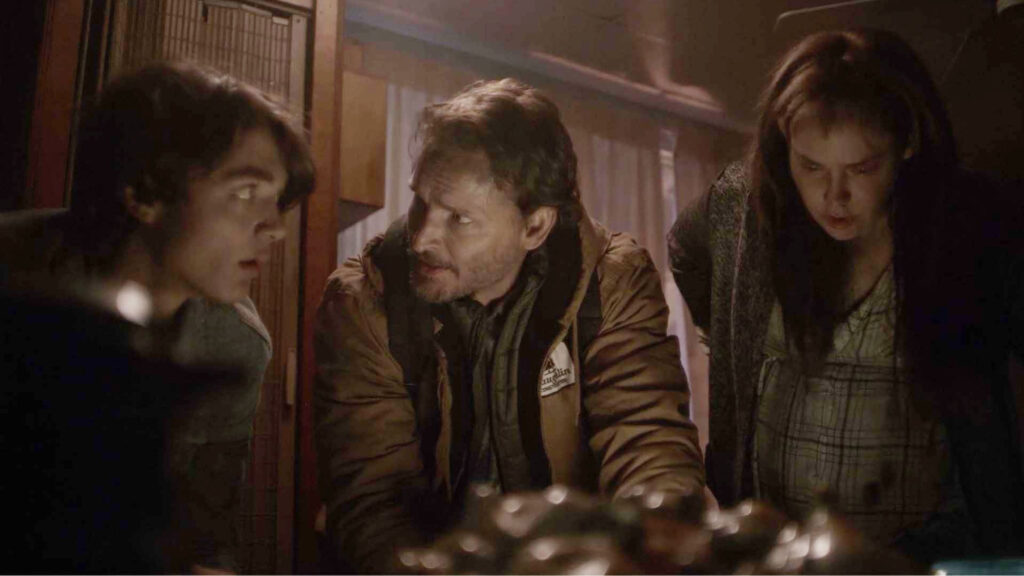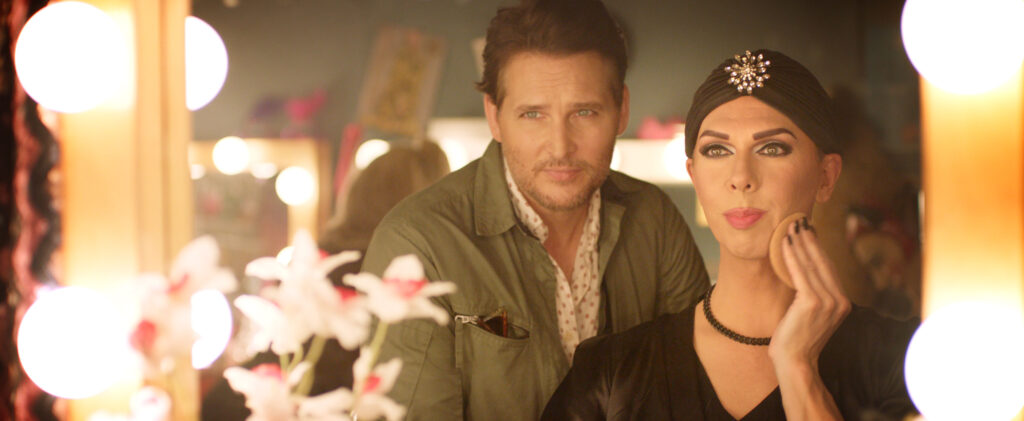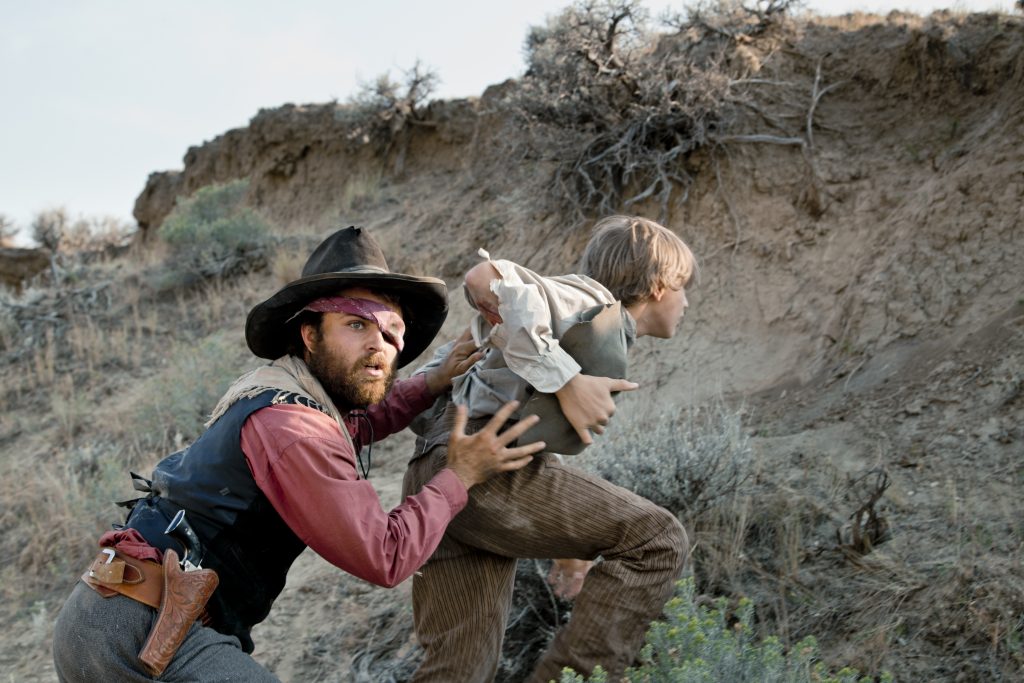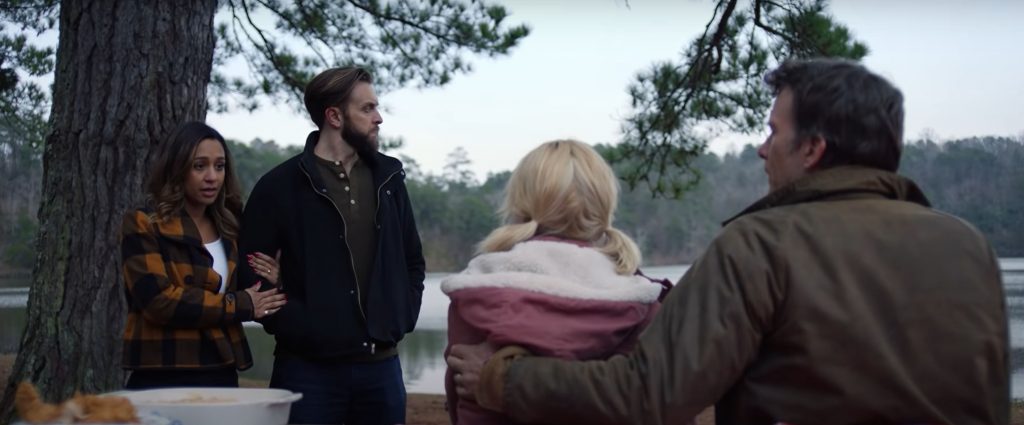October 7, 2023
by Carla Hay

Directed by Peter Facinelli and Nick Lyon
Culture Representation: Taking place in the fictional city of Colberg, California, the dramatic film “On Fire” features a predominantly white cast of characters (with a few African Americans) representing the working-class and middle-class.
Culture Clash: During a forest fire that rages through more than one city, a building construction worker disregards warnings not to go into the fire, so that he can rescue his family members who are trapped.
Culture Audience: “On Fire” will appeal primarily to people who like suspsenseful movies about forest fires.

“On Fire” is a mostly credible depiction of a family trapped in a forest fire. This adrenaline-packed drama, which has solid acting and serviceable visual effects, is a blend of predictable and unpredictable. Along with the family crisis are various attitudes about the correlation between climate change and forest fires.
Written and directed by Peter Facinelli and Nick Lyon, “On Fire” has a simple concept but it does fairly well in stretching out the concept into a briskly paced 80-minute movie. Lyon and Ron Peer co-wrote the “On Fire” screenplay. It’s the type of movie that will never be considered for any major awards, but it’s not a bad way to pass the time for viewers who are looking for a movie that does a good job of balancing the natural disaster aspects of the story with the human relationship aspects of the story.
“On Fire” starts off by letting viewers get to know the family at the center of the story, which takes place mostly within a 24-hour period. In the fictional city of Colberg, California, the Laughlin family lives in a fairly isolated wooded area. (“On Fire” was filmed on location in Northern California.) The family members are tight-knit but have their share of conflicts and squabbles.
Married couple Dave Laughlin (played by Facinelli) and Sarah Laughlin (played by Fiona Dourif) have a loving marriage. Dave has recently started his own building construction business, which hasn’t been profitable yet. It’s caused some tension in his otherwise happy marriage. Sarah thinks Dave should consider doing a job where he can make money, but Dave doesn’t want to give up his struggling construction business.
Sarah, who is eight months pregnant, is working during her pregnancy in some sort of customer-related job where she has to wear a name tag and be on her feet for hours. Whevever she works, either the place does not offer paid maternity leave to full-time employees, or Sarah works there part-time and doesn’t qualify for maternity leave. Sarah has to work because she and Dave are heavily in debt, mainly because of the costs of starting his business.
Dave and Sarah live with their teenage son Clay Laughlin (played by Asher Angel), who is in his last year of his high school. Clay, who is good guy, is a talented athlete on his school’s track team. Also living in the household is Dave’s 80-year-old widower father George Laughlin (played by Lance Henriksen), who uses an oxygen tank. George has respiratory problems because he’s been a heavy smoker for years.
George is cranky and rude, usually to Sarah, because he resents the fact that she won’t let George smoke cigarettes, and she monitors other things about his health. During an argument between Sarah and George, he calls her a “bitch.” Sarah gets upset, while Dave comforts her. Dave tells Sarah that George is difficult with Sarah because Sarah reminds George of George’s late wife Rosemary, who was also strong-willed and outspoken.
In the few hours leading up to the forest fire that reaches Colberg, the family smells smoke from a forest fire going on in the nearby city of Parker. All the news reports are saying that Colberg is not in any immediate danger, because a ravine separates Parker and Colberg. There also hasn’t been a forest fire in Colberg for at least 40 years.
However, members of the Laughlin family notice some other warning signs (besides the overwhelming smell of fire smoke) that Colberg will soon be in danger from the forest fire. A huge flock of birds are seen fleeing in the opposite direction of Colberg. The sky also starts to get darker from smoke, even though it’s still in the afternoon.
Dave doesn’t want to take any chances, so he goes to the nearest hardware store to stock up on fire safety supplies. The store’s owner Marv (played by Glenn Morshower) is one of the people who says he’s not worried about the fire reaching Colberg. Dave, who already owes the hardware store some money, tells Marv to put all the supplies that Dave gets on Dave’s running tab of debt.
Of course, it’s no secret that the fire does reach Colberg. It happens so quickly, residents barely have time to evacuate when the emergency alert is sent. The fire in Colberg is later identified as a spot fire, which is ignited by embers that float from the perimeter of the main fire.
After leaving the hardware store, Dave frantically drives toward his home to help his family evacuate, but there’s a police roadblock in the way, because it’s unsafe to go back into that part of the woods. Dave desperately tells the police officers at the roadblock that his family needs help evacuating. Dave is told a rescue team can go to Dave’s family, but Dave gets impatient and drives through the roadblock.
The rest of “On Fire” shows many obstacles that the Laughlin family members experience in their attempts to go to a safe area. There are car-related mishaps, cell phones that can’t work because the fire is affecting cell phone towers, and more than a few injuries. In addition, as the fire rages around them, there’s the danger of smoke inhalation. Sarah’s pregnancy is also a major concern.
Interspersed with scenes of the Laughlin family’s ordeal are scenes of a 911 operator named Kayla (played by Ashlei Foushee) taking phone calls from scared and confused people who are trapped in the fire. It’s Kayla’s second week on the job. Although she keeps calm while he’s on the phone with callers, the movie shows how the stress starts to get to Kayla when she’s not on the phone.
“On Fire” doesn’t get preachy about climate change, but the movie does show how people have different views about how climate change can be connected to an increase in forest fires. Current scientific research shows that global warming creates an environment that makes it easier for forest fires to start and spread. Marv is the type of person who is basing his opinions on how things were in the past, instead of acknowledging current science. Dave is the type of person is more open to looking at the current science of the environment, because his work in building construction depends a lot on environmental issues.
“On Fire” makes good use of its low budget and a relatively small number of cast members to make the movie an engrossing experience if viewers don’t have high expectations. Not everything in the movie looks completely realistic. The smoke inhalation issue would be a lot more serious in real life, compared to how it looks in the movie. And some of the dialogue and scenes are a little corny, especially toward the end. However, “On Fire” delivers an engaging and memorable story about a family who have to fight for their lives during a natural disaster.
Cineverse released “On Fire” in U.S. cinemas on September 29, 2023.






